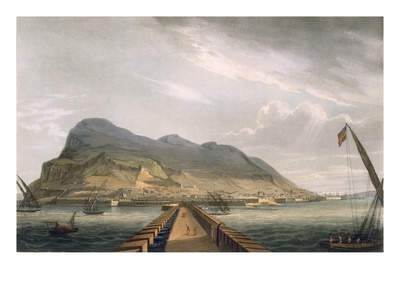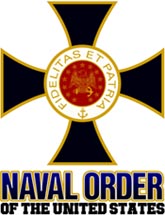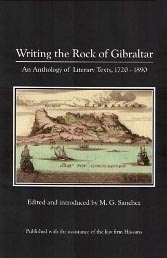Maritime Nations
Gibraltar
The rock of Gibraltar occupies a strategic position at the eastern entrance to the narrow strait and guards the only exit from the Mediterranean to the Atlantic. Early mariners did not pass the rock for fear of the currents. The Phoenicians sailed past it and used it as an important landmark, marking the entrance to the Atlantic. The Greeks gave it the name Calpe which means urn, possibly because of its shape. The name of Gibraltar comes from the Arabs who invaded Spain in the VIII century; it has been altered over the centuries to its present form of Gibraltar.
It wasn't until the time of Cromwell when Britain first became interested in the rock but it was not captured until the War of the Spanish Succession. Gibraltar became a British garrison in 1830 and was declared a colony. Twice during the 18th century Spain tried to recapture it without success. The Great Siege commenced on June 21, 1779 and lasted nearly 4 years during which time the rock was defended by a force of 7,000.
January 1, 1783, The European Magazine, London
Summary Account of the Proceedings in Parliament.
This conversation being ended, Lord Grantham moved, after a short exordium that the thanks of this house be given to General Eliott, for the important Services he has done to this country by his brave and gallant defence of Gibraltar; and that the fame be communicated to him by the Lord Chancellor."
"That the thanks of this House he given to the Right Hon. Lord Viscount Howe, for the important service he had done to this country, by the relief of the fortress of Gibraltar, and by his gallant and able manoeuvres of the fleet under his command, against a fuperior fleet of the enemy; and that the fame be communicated to him by the Lord Chancellor."
"That the thanks of this House be given to Lieutenant-General Boyd, General La Motte, Major-General Greene, Chief Engineer, to Sir Roger Curtis, lately employed in the defence of Gibraltar; and that the Lord Chancellor do communicate the fame to them."
"That this House do highly approve of and acknowledge thefervices of the officers, soldiers, and sailors, lately employed in the defence of Gibraltar and that General Eliott do signify the fame to them, and thank them for their gallant behaviour.''
"That this House doth highly approve of and acknowledge the services of the officers, soldiers, and sailors, lately employed in the relief of Gibraltar; and that Lord Vifcount Howe do signify the same to them, and thank them for their gallant behaviour."
All ordered nem. con.
The battle ended on February 2, 1783 and the city took many years to rebuild.
June 8, 1805, The Times, London, United Kingdom
View of Gibraltar, Engraved by Thomas Suterland for J. Jenkin's "Naval Achievements," 1816 |
Letters from Gibraltar, of the 18th of May, state, that the Queen and Dragon men of war, with the expedition under their convoy, arrived at Gibraltar on the 13th of that month. The troops under General Craig were all in good health and spirits. The brigade of horse had been disembarked at Europa Point, for refreshment, and one of the regiments of infantry was also landed to reinforce tbe garrison of Gibraltar.
The above letters do not mention that tbe expedition had sailed again, or that the Queen and Dragon bad joined Lord Nelson, as was stated in some of the Evening Papers of yesterday. It is, however, asserted, with great confidence, that the expedition would shortly sail for Malta, to reinforce the garrison there, after attempting a coup-de-main at Port Mahon. Had the expedition arrived a few weeks earlier, no doubt was entertained at Gibraltar of Port Mabon having surrendered to it without firing a gun. In the present circumstances, some resistance is expected, it being understood that troops have lately been sent to Minorca.
The British garrison was formally declared a colony in 1830. In a referendum held in 1967, Gibraltarians voted overwhelmingly to remain a British dependency. The subsequent granting of autonomy in 1969 by the United Kingdom led to Spain closing the border and severing all communication links.
January 13, 1826, The Edinburgh Advertiser, Edinburgh, United Kingdom
Spain and Portugal. Madris, Lisbon, Gibraltar, Iberia. Tallis/Rapkin, Mapmakers. 1851.

We have seen letters from Gibraltar, dated the 19th ultimo, that reflect the highest credit on the character of Sir John Phillimore, of the Thetisfrigate, and the English Governor, General Don, for their conduct in giving relief to the sufferers from the late hurricane, but which will probably bring down upon England the wrath of Ferdinand. It would appear the Spanish Authorities refused all assistance to the shipwrecked mariners, and would oppose tbe English from the garrison proceeding to their relief, the English commandants simultaneously ordered a force to proceed by land, and the crew of the Thetis to proceed in boats, to give assistance in preserving the lives and the property of individuals; of course this spirited conduct met with no opposition, but we understand the proceedings have given the highest offence to the Spanish authorities, and that the conduct of the English has been strongly represented to the Spanish Court, in a despatch sent off express. ~ Globe.
May 7, 1892, Galveston Daily News, Galveston, Texas, USA
Pirates Still Exist in the Mediterranean.

Gibraltar, May 2,--A Spanish sailing vessel bound for Albucomas, a small island fortress and prison settlement in the Mediterranean belonging to Spain, while off the coast of Morocco became becalmed and drifted shoreward. A number of pirates, seeing her condition, boarded and looted her. While the pirates were handling their spoils, a breeze sprang up and the captain slapped on all sail and headed for this port, where he arrived this morning.
July 26, 1900, Emmett County Reputlican, Esterville, Iowa, USA
The Rock of Gibraltar.

England's famous natural fortification is stiuated at the southern extremity of Spain, in Andalusia. At various times great sums of money have been expended to add to its impregnability, until uow it is regarded as an almost indestructible stronghold. The chief points of defense are on its western side. Several miles of caverns and galleries penetrate the rock, which presents a solid and formidable front on the landside; on the other great cannon frown upon the Bay of Gibraltar. The fortress is fairly honeycombed with bombshells and cannon balls. It was taken from the original owner over 150 years ago.
Empires of the Sea: The Siege of Malta, the Battle of Lepanto, and the Contest for the Center of the World in 1521
Roger Crowley
Suleiman the Magnificent, Muslim ruler of the Ottoman Empire, dispatched an invasion fleet to the Christian island of Rhodes. This would prove to be the opening shot in an epic clash between rival empires and faiths for control of the Mediterranean and the center of the world. In Empires of the Sea, acclaimed historian Roger Crowley has written a thrilling account of this brutal decades-long battle between Christendom and Islam for the soul of Europe, a fast-paced tale of spiraling intensity that ranges from Istanbul to the Gates of Gibraltar. Crowley conjures up a wild cast of pirates, crusaders, and religious warriors struggling for supremacy and survival in a tale of slavery and galley warfare, desperate bravery and utter brutality. Empires of the Sea is a story of extraordinary color and incident, and provides a crucial context for our own clash of civilizations.
Pirates of Barbary: Corsairs, Conquests and Captivity in the Seventeenth-Century Mediterranean
Adrian Tinniswood
If not for today's news stories about piracy on the high seas, it'd be easy to think of pirating as a romantic way of life long gone. But nothing is further from the truth. Pirates have existed since the invention of commerce itself, and they reached the zenith of their power during the 1600s, when the Mediterranean was the crossroads of the world and pirates were the scourge of Europe. Historian and author Adrian Tinniswood brings this chapter in history alive, revealing that the history of piracy is also the history that has shaped our modern world.
1899. World's Fleet. Boston Daily Globe
Lloyds Register of Shipping gives the entire fleet of the world as 28,180 steamers and sailing vessels, with a total tonnage of 27,673,628, of which 39 perent are British.
| Great Britain | 10,990 vessels, total tonnage of 10,792,714 |
| United States | 3,010 vessels, total tonnage of 2,405,887 |
| Norway | 2,528 vessels, tonnage of 1,604,230 |
| Germany | 1,676 vessels, with a tonnage of 2,453,334, in which are included her particularly large ships. |
| Sweden | 1,408 vessels with a tonnage of 643, 527 |
| Italy | 1,150 vessels |
| France | 1,182 vessels |
For Historical Comparison
Top 10 Maritime Nations Ranked by Value (2017)
| Country | # of Vessels | Gross Tonnage (m) |
Total Value (USDbn) |
|
|---|---|---|---|---|
| 1 | Greece | 4,453 | 206.47 | $88.0 |
| 2 | Japan | 4,317 | 150.26 | $79.8 |
| 3 | China | 4,938 | 159.71 | $71.7 |
| 4 | USA | 2,399 | 55.92 | $46.5 |
| 5 | Singapore | 2,662 | 64.03 | $41.7 |
| 6 | Norway | 1,668 | 39.68 | $41.1 |
| 7 | Germany | 2,923 | 81.17 | $30.3 |
| 8 | UK | 883 | 28.78 | $24.3 |
| 9 | Denmark | 1,040 | 36.17 | $23.4 |
| 10 | South Korea | 1,484 | 49.88 | $20.1 |
| Total | 26,767 | 87.21 | $466.9 | |






 Mediterranean Pirates
Mediterranean Pirates


 Copyright ~ 1998-2018.
Copyright ~ 1998-2018. 